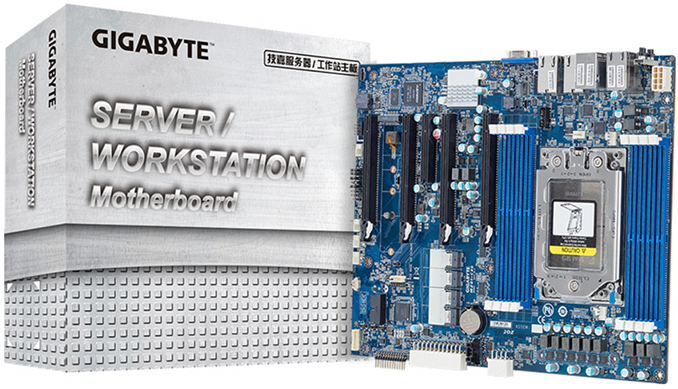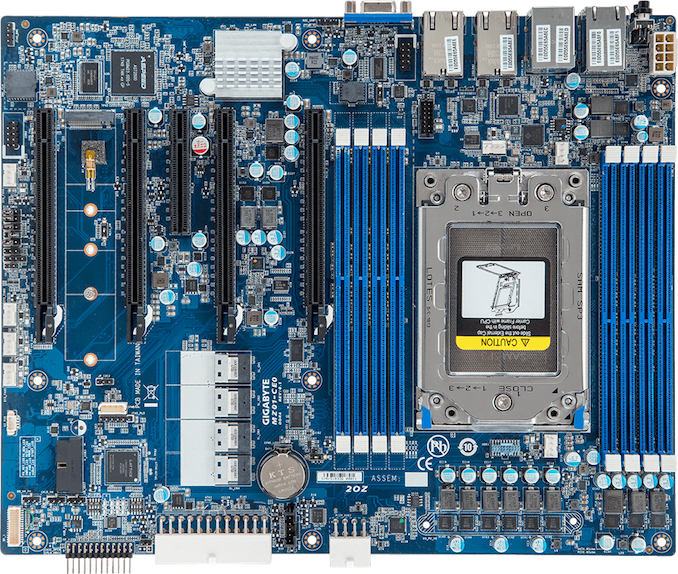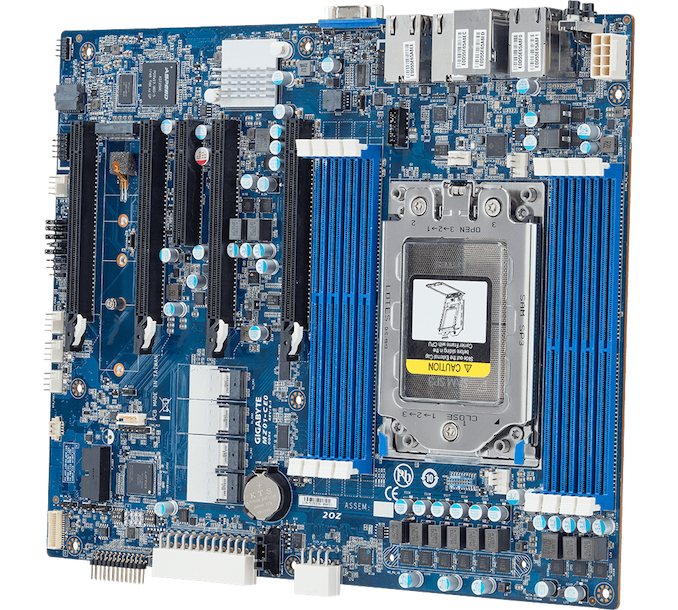AMD EPYC for ATX Workstations: GIGABYTE MZ01-CE0 & MZ01-CE1 Motherboards
by Anton Shilov on November 7, 2018 4:00 PM EST- Posted in
- Workstations
- AMD
- Gigabyte
- EPYC
- GIGABYTE Server

AMD’s EPYC processor has made it into servers and supercomputers, yet it still has to find its place inside workstations. To a large degree that is because up until recently there were no motherboards for these CPUs on the market. ASRock Rack was first to showcase such a mainboard at Computex. Now, GIGABYTE is coming up not with one, but with two ATX mobos for AMD’s EPYC aimed at workstations.
GIGABYTE’s lineup of ATX motherboards for AMD’s EPYC consists of two motherboards, the MZ01-CE0 and MZ01-CE1. Both feature a socket for AMD’s EPYC, four PCIe x16 slots (as expected from a CPU that has 64 128 spare PCIe lanes) compatible with dual-slot graphics cards and accelerators, a PCIe x8 slot, eight DDR4 slots supporting up to 1 TB of DDR4 ECC memory, an M.2 slot for SSDs, and four SlimSAS ports for up to 16 SATA storage devices.
Despite being ATX-compatible, the two motherboards from GIGABYTE can be used to build both workstations as well as servers. The MZ01-CE0 and MZ01-CE1 platforms come equipped with Aspeed’s AST2500 BMC for remote management as well as GIGABYTE’s Server Management software.
Both MZ01-CE0 and MZ01-CE1 motherboards come equipped with two onboard Intel I210 GbE LAN controllers. Meanwhile, the MZ01-CE0 is also outfitted with two extra 10 GbE Base-T LAN ports (controlled by the Intel X550 chip) for those who have appropriate networks for transferring large files from one system to another (something quite common in movie industry, for example).
GIGABYTE has not touched upon MSRPs of its EPYC-supporting motherboards because they will be available mostly to B2B customers. Meanwhile, being unique products for server CPUs and equipped with expensive network controllers, the MZ01-CE0 and MZ01-CE1 will certainly carry premium price tags.
| GIGABYTE's ATX Motherboards for AMD EPYC CPUs | |||
| MZ01-CE0 | MZ01-CE1 | ||
| Supported CPUs | AMD Socket 4094 AMD EPYC processors with up to 32 cores and 180 W TDP |
||
| PCH | AMD | ||
| Graphics | Aspeed’s AST2500 BMC 4 × PCIe 3.0 x16 slot |
||
| Display Outputs | 1 × D-Sub | ||
| Memory | 8 × DDR4 DIMM Up to 1 TB of DDR4 with ECC |
||
| Slots for Add-In-Cards | 4 × PCIe 3.0 x16 1 × PCIe 3.0 x8 |
||
| Ethernet | LAN 1: Intel I210AT GbE PHY LAN 2: Intel I210AT GbE PHY LAN 3: Intel X550 10 GbE PHY LAN 4: Intel X550 10 GbE PHY MLAN: Realtek RTL8211E |
LAN 1: Intel I210AT GbE PHY LAN 2: Intel I210AT GbE PHY MLAN: Realtek RTL8211E |
|
| Storage | M.2 | 1 × M.2-22110 (PCIe 3.0 x4) | |
| SATA | 16 × SATA 6 Gbps via four SlimSAS ports | ||
| Audio | none | ||
| USB | 2 × USB 3.1 Gen 1 Type-A | ||
| Serial Ports | 2 × internal COM port | ||
| Other I/O | 1 × TPM header (some SKUs come with pre-installed TPM) 2 × internal USB Type-A (for front panel) |
||
| Monitoring | CPU Temperature Fan RPM |
||
| Management | GIGABYTE Server Management (GSM) Aspeed AST2500 management controller Avocent MergePoint IPMI 2.0 web interface |
||
| Compatibility |
Windows Server 2012 R2 (x64) Red Hat Enterprise Linux 6.9 SUSE Linux Enterprise Server 11.4 Ubuntu 16.04 VMware ESXi 6.5 |
||
| Form-Factor | ATX (305 mm × 244 mm | 12" × 9.6") | ||
Related Reading:
- ASRock Rack Goes AMD: EPYCD8 Workstation Motherboard
- Oracle puts AMD EPYC in the Cloud
- iBASE Unveils FWA8800: AMD EPYC Embedded-Based Network Appliance
- Cray Adds AMD EPYC Processors to CS500 Cluster Supercomputers
- More EPYC Servers: Dell Launches 1P and 2P PowerEdge for HPC and Virtualization
- Microsoft Announces Azure VMs with Dual 32-core AMD EPYC CPUs
- HPE Unveils ProLiant DL385 Gen10: Dual Socket AMD EPYC
Source: GIGABYTE












28 Comments
View All Comments
duploxxx - Friday, November 9, 2018 - link
not seen any, they are probably all under the embargo of intel. When they would even try to build a WS that off course would kick ass the competition they will loose all the r&d funding from intel....csell - Friday, November 9, 2018 - link
Can any confirm the PCIe 3.0 x16 slot?AMD just demoed the coming Zen 2 EPYC at the Next Horizon event with PCIe 4.0 x16 slot.
phoenix_rizzen - Tuesday, November 13, 2018 - link
The MZ01-AR0 motherboard that these appear to be based on has PCIe 3.0 slots. We have one of those in our server room.These motherboards are for the first-gen EPYC CPUs that are currently available. No motherboards have been shown yet for the second-gen EPYC CPUs (aka "Rome") that will support PCIe 4.0.
phoenix_rizzen - Tuesday, November 13, 2018 - link
The MZ01-AR0 motherboard that these appear to be based on has PCIe 3.0 slots. We have one of those in our server room.These motherboards are for the first-gen EPYC CPUs that are currently available. No motherboards have been shown yet for the second-gen EPYC CPUs (aka "Rome") that will support PCIe 4.0.
BeZnojeK - Saturday, November 10, 2018 - link
I believe in amd. We are waiting for a new generation of processors at the right price!phoenix_rizzen - Tuesday, November 13, 2018 - link
The MZ31-CE0 is pretty much the perfect motherboard for a storage server.Dual-10g Ethernet, 5 PCIe slots for storage controllers, and 16 SATA3 ports onboard.
Stick that into a 2U server with LSI 9305-16e controllers connecting a bunch of JBOD chassis and you have the makings for a great SAN/NAS setup.
Foeketijn - Friday, December 14, 2018 - link
In which situation would you put an EPIC CPU in your WS instead of an Threadripper?In the end a big part of the total calculation power comes down to the power envelope available.
When would you need a more expensive WS with less CPU power?
ajc9988 - Sunday, December 16, 2018 - link
Easy, with the 7371 that is being released, granted only a 16-core like my 1950X in my current workstation, you get 3.6GHz all core, 3.8GHz on 8-cores. So, it is roughly a 1950X but with the full accoutrements of 8 memory channels and 128 PCIe lanes.Seeing as I already have a 1950X that I've owned since release, I cannot justify the estimated $1400-1500 price of the Epyc 7371, but will be able to justify the switch to something like this when I upgrade the workstation. With the Asrock Epyc workstation board, it has more of the features that fit my uses than these Gigabyte boards, but with vendors now supporting such rigs, I have definitely made the decision to get something like that with the speed optimized Epyc 2 chips.
I am still torn, though, as Zen 3 Epyc 3 should support DDR5, and justifying buying registered versus unbuffered is easier when moving to a new platform such as that (along with PCIe 5.0 being finalized likely in Q1 2019).
Either way, comparing this to the 28-core Xeon from Intel with 6-channel memory and only like 40 or 48 lanes while needing two PSUs to run makes this an easy decision, for me at least.